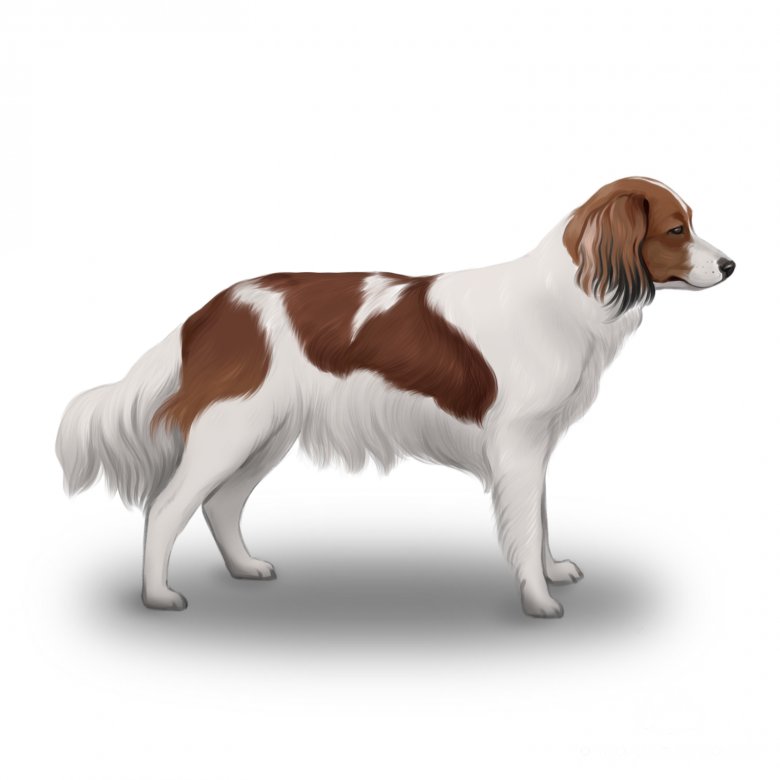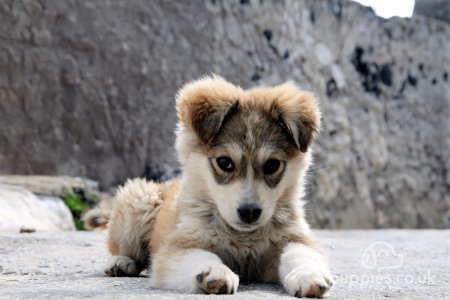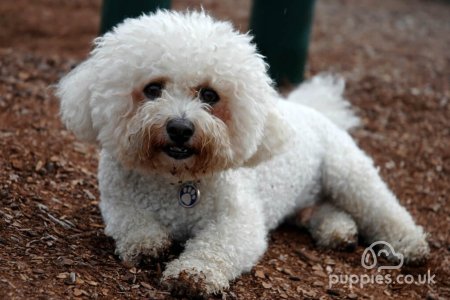Kooikerhondje (Nederlandse Kooikerhondje, Kooiker Hound, Kooiker, Small Dutch Waterfowl Dog)
Overview
The small, adorable, and intelligent Kooikerhondje is a wonderful companion pet hailing from the Netherlands. Perhaps due to his cleanliness and cheery attitude, his popularity in the UK is growing as many families are happily welcoming Kooiker Hounds into their homes.
Dutch for ‘small cager dog,’ Kooikers are a spaniel-type breed originally bred for duck and waterfowl hunting, although today they are a utility breed that can adapt fairly well to all sorts of various environments.
Physical Appearance
Kooikerhondjes are small-sized orange and white coloured dogs with a signature plumed tail, which was originally used for enticing and luring ducks and waterfowl. Their stance is moderately muscular and their proportions are nearly square.
Their ears are moderately large in proportion to their muzzle and body, feathered, and with black hair tips being desirable. Their eyes are almond-shaped and appear friendly yet alert. Their gait is full of energy, both flowing and well-extended.
Kooikers have a medium-length, wavy coat of soft hair in orange-red patches on white. Black hair ‘earrings’ are desirable but are not preferable elsewhere.
This breed somewhat resembles the Nova Scotia Duck Tolling Retriever, a breed that may possibly have derived from the Kooikerhondje.
How big do Kooikerhondje dogs get?
Character Traits
The Kooikerhondje is a lively, cheerful breed that always appears to be good-natured and well-behaved, although he is always alert. They are well-known for having a highly variable temperament, so no two Kooikers are exactly alike and each will have his own unique temperament depending on his domestic environment.
Generally, Kooikers are quite playful and can become loyal companions with proper socialisation. Owing to their intelligence, they are also fairly easy to train. Their medium energy levels mean that owners should give them sufficient exercise and stimulation, but they are not nearly as demanding as many other breeds.
Although small, Kooikers are territorial and as such make for excellent watchdogs. They are not as ideal for guard dog duties, however.
Are Kooikerhondje dogs intelligent? Yes.
Are Kooikerhondje dogs affectionate? Yes.
Do Kooikerhondje dogs have high or low energy levels? Medium energy.
Are Kooikerhondje dogs loyal? Yes.
Are Kooikerhondje dogs playful? Yes.
Are Kooikerhondje dogs aggressive? No, almost never show signs of aggression.
Are Kooikerhondje dogs easy to train? Yes, very.
Are Kooikerhondje dogs good guard dogs? Not really, but they make excellent watchdogs as they are very alert.
Ability to Socialise
Kooikers get along well with owners and their families, and as they grow from puppies into adults can become loyal and loving companions. At first sight, however, they may be a little boisterous and exercise their territorial instincts, so ensure that young children are properly supervised around them.
Around other dogs, Kooikers often get along fairly well provided they’ve had sufficient socialisation and training.
As a breed with a high prey drive, they are prone to chasing small animals and pets like cats or other dogs. For this reason, keep them on a lead in public.
Do Kooikerhondje dogs get along with other pets? Somewhat, but they are prone to chase.
Do Kooikerhondje dogs get along with other dogs? Yes, generally.
Are Kooikerhondje dogs good with kids? Yes, but they may be boisterous around young children.
Are Kooikerhondje dogs good with strangers? Yes, but they will often bark at strangers.
Lifestyle Suitability
Kooikerhondjes are best suited to living in a home with some space in which they can play and roam, but they are adaptable to apartments as well. If you do not have access to a garden, make sure you take your Kooiker out for frequent walks outdoors and allow him some space to roam, off-lead if safe and possible.
In terms of behaviours, Kooikers do not drool much and only shed a moderate amount of hair. They are occasional barkers, and will most likely bark at any strangers or passersby until they’ve become acquainted and socialised.
Although they are wonderful, loving pets, first-time owners may wish to consider other breeds instead. Kooikers have such a temperament that may make it challenging to raise them as a first-time owner.
Are Kooikerhondje dogs good for first-time owners? Not really.
Are Kooikerhondje dogs hypoallergenic? No.
Are Kooikerhondje dogs prone to drooling? No.
Are Kooikerhondje dogs a good breed for apartment living? Somewhat, but they prefer being in more spacious environments.
Do Kooikerhondje dogs shed a lot? Moderately.
Do Kooikerhondje dogs bark a lot? Occasionally.
Can Kooikerhondje dogs be left alone at home? Yes, but only for brief periods.
Can Kooikerhondje dogs handle the heat? Somewhat.
Can Kooikerhondje dogs handle cold temperatures? Yes.
Are Kooikerhondje dogs sensitive to loud noises? Yes.
General Health & Health Issues
Kooikerhondjes are a relatively healthy breed, about on par with most other breeds. Hereditary diseases are fairly common due to their small genetic pool, and one particular disorder to keep an eye out for is bloat and overeating. Although most breeds can suffer from bloat as they age, Kooikers have a big appetite and can easily develop bloat more than other breeds.
Even if your Kooiker appears to be perfectly healthy, it is always a good idea to schedule routine checkups with your local veterinarian to ensure he’s in good health and to diagnose any potential health problems sooner rather than later.
Some common problems include:
Epilepsy: as with humans, some dog breeds - Kooikers included - can suffer from epileptic seizures. Can be managed with proper care;
Bloat: Kooikers have a big appetite, which makes them quite prone to bloat and eating disorders if owners do not maintain a strict feeding regimen;
Hereditary Necrotising Myelopathy (ENM): a neurological disease that affects Kooikers. Can be prevented through DNA testing;
Von Willebrands disease: a common blood clot disorder that is caused by deficiencies of Von Willebrand factor. Can be diagnosed and prevented through DNA testing.
How long do Kooikerhondje dogs live? - 12-15 years
Exercise & Play Time
Kooikerhondjes are a medium energy breed, so they should be getting frequent exercise outdoors and be permitted to play and roam whilst supervised. Budget about an hour every day to take your Kooiker out for a nice walk, and allow plenty of off-lead time at home in the garden if possible.
Originally bred for hunting waterfowl, Kooikers have a prey drive that must be satiated. Throwing a stick or ball will keep them happy and tired, which is important for good health. Furthermore, since Kooikers were bred for hunting ducks and other waterfowl, they normally have no problem at all splishing and splashing in watercourses.
Young puppies should be introduced to water gradually so as to avoid traumatisation, but once they’re accustomed to dipping their paws in the water they’ll be swimming whenever they get the chance.
How much exercise does a Kooikerhondje dog need? - About 1 hour per day
Do Kooikerhondje dogs like water play? Yes, they love to be around water.
Nutrition & Feeding
Although small in stature, Kooikers have a fairly large appetite and should be fed only high-quality dog food rich in nutrients and complete with proteins, vitamins, and minerals to promote good health. Raw and cold-pressed diets may be a good alternative to kibble but speak with your veterinarian before making any significant modifications to the breeder’s feeding schedule.
Puppies should be fed in three or four sessions daily whilst adult Kooikers should be fed twice daily. It is crucial that you maintain a strict regimen for feeding, and only adjust as necessary and while monitoring any weight gain that may arise from overfeeding. Kooikers are prone to bloat and overeating.
Are Kooikerhondje dogs prone to weight gain? Yes.
How much should I feed a Kooikerhondje puppy? About 100-180g per day, in 3-4 sessions.
How much should I feed an adult Kooikerhondje dog? About 125-160g per day, in total.
Care & Maintenance
Grooming for your Kooiker shouldn’t be too demanding, with only a couple of grooming sessions per week to maintain their beautiful tan and white coats. Although they do shed a fair amount of hair, there aren’t any specific grooming requirements out of the ordinary.
In terms of emotional care, Kooikers love to be around others and may become bored if left alone for too long. They develop a loving, faithful connection to their owners and their families, so that love should be reciprocated frequently.
- Grooming: once or twice a week, use a brush to remove any dead hairs and to keep their coat healthy and beautiful. Take care around sections of their ears and tail with longer hair, which can become tangled fairly easily. Inspect their ears and eyes for possible infections.
- Emotional care: Kooikers will not tolerate being left alone for more than a few hours, and may become bored and possibly destructive, chewing shoes, furniture, and upholstery, for example. Do not make a habit of leaving him alone for too long, too often.
History of the Kooikerhondje
The exact origins of the Kooikerhondje are unclear, although many have claimed that it is the ancestor of the Nova Scotia Duck Tolling Retriever. What is more certain, however, is that the breed was widely used as far back as the 16th century in the Netherlands.
The etymology of the Dutch Kooikerhondje can be traced to kooien ‘cages,’ shaped like a canal with traps at both ends suitable for trapping ducks and waterfowl, ergo Kooiker ‘hunter,’ and hondje ‘dog’ (c.f. hound). This breed was most prevalent in his native Netherlands and remains rare in the UK and elsewhere to this day.
During the Second World War, Kooikerhondjes were nearly driven to extinction. Numbers stabilised following the war and the breed was officially recognised by the Dutch Kennel Club in 1971. The breed is recognised by the Kennel Club here in the UK, although its original classification as a gundog was later modified in 2014 to utility instead.
Interesting Facts About Kooikerhondje Dogs
Famous painters such as Rembrandt and Jan Steen have depicted this majestic breed in paintings from the 17th and 18th centuries;
Although high in demand, Kooikerhondjes remain extremely scarce in supply in the UK. Less than a hundred are registered in the UK as of 2021;
The Kooikerhondje’s magnificent tail acts as a decoy and lure for ducks, whereby the Kooiker draws the duck out of hiding and towards the tail and ultimately into a hunter’s trap.
Getting a Kooikerhondje Puppy
For a prospective pet owner looking to purchase a Kooikerhondje puppy, it is important to consider your duties and responsibilities beforehand. Please consult our buying guide for more information on how to avoid purchasing from puppy mills and how to purchase a healthy, happy puppy bred in ethical conditions.
How much does a Kooikerhondje cost to buy? - About £600-£900.
How much does a Kooikerhondje cost to feed? - An adult Kooikerhondje costs about £1.00-£1.40 per day to feed.
How much does insurance for a Kooikerhondje cost? - About £25-£45 per month.
Sensible alternatives to purchasing a new Kooikerhondje puppy include rescue and adoption.
Additional resources can be found via Kooikerhondje registries and associations such as:











